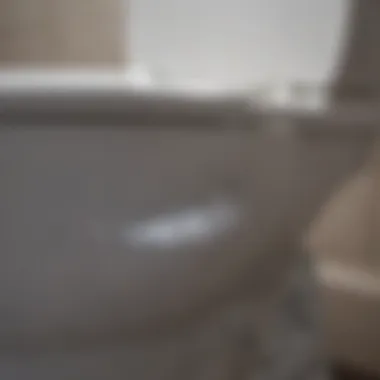Effective Strategies to Remove Hard Water Buildup


Intro
Hard water can be an annoying problem in many households. It is characterized by a high concentration of minerals like calcium and magnesium, which can create buildup in toilets and other plumbing fixtures. When hard water is left untreated, it can lead to unsightly stains, and potentially costly plumbing issues. Understanding hard water and its effects is crucial for homeowners who want to maintain clean and efficient facilities.
In this guide, we will explore various methods for eliminating hard water buildup in toilets, including chemical solutions and natural alternatives. We will also highlight preventive measures and maintenance tips to keep toilets functioning well. This comprehensive approach helps homeowners tackle the issue systematically, ensuring that toilets remain clean and free from mineral deposits.
Understanding Hard Water
Hard water is not inherently harmful to health, but it can cause several problems in the home. Deposits from hard water accumulate over time in toilets, sometimes appearing as white or brown stains. These deposits can clog pipes and reduce the efficiency of toilets, leading to higher water bills and possible plumbing problems. Knowing how to effectively treat hard water can save time and money in the long run.
Effects of Hard Water on Toilets
- Visual Stains: Hard water leads to visible stains and discoloration in toilet bowls.
- Reduced Efficiency: Mineral buildup can cause toilets to flush less effectively.
- Plumbing Issues: Over time, these deposits can build up in the plumbing system, leading to clogs.
"Regular maintenance can prevent many of the issues associated with hard water buildup in toilets."
Practical Methods to Eliminate Hard Water Buildup
Dealing with hard water stains requires both immediate and long-term strategies. Below is an outline of recommended approaches.
Chemical Solutions
Chemical solutions can be effective in quickly eliminating hard water stains. Some popular products include:
- CLR Calcium, Lime and Rust Remover: This powerful cleaner dissolves mineral buildup effectively.
- Lime-A-Way: Known for its ability to tackle tough lime scale and stains.
- Vinegar and Baking Soda: A natural, yet powerful combination for a less chemical-intensive approach.
Steps for Using Chemical Solutions:
- Apply the cleaner to the toilet bowl.
- Let the solution sit for the recommended time.
- Scrub the stains with a brush and flush.
Natural Solutions
Some homeowners prefer using natural methods to address hard water stains. These include:
- White Vinegar: Pouring vinegar into the bowl can help break down mineral deposits.
- Baking Soda: Adding baking soda after vinegar can boost the effectiveness.
- Borax: This compound can be sprinkled in the toilet bowl to target stains.
Prevention Techniques
Preventing hard water buildup can save time and effort in the future. Here are some tips:
- Water Softeners: Consider installing a water softener to reduce mineral content.
- Regular Cleaning: Clean the toilet bowl weekly to prevent buildup.
- Routine Inspections: Check for signs of hard water periodically and address them promptly.
Maintenance and Upkeep
Maintaining a toilet regularly can help reduce hard water problems. Follow a seasonal maintenance checklist to stay on top of cleaning and repairs.
Seasonal Maintenance Checklist
- Check for leaks and water flow issues.
- Inspect for stains and treat as necessary.
- Test the water hardness and adjust water softeners if necessary.
Cleaning and Organization Tips
- Keep cleaning supplies readily available under the sink.
- Set reminders for regular cleaning schedules.
- Encourage family members to report any issues with toilet performance.
Understanding Hard Water
Understanding hard water is crucial when addressing issues related to mineral buildup in toilets. Hard water contains high levels of dissolved minerals, primarily calcium and magnesium. This mineral content can lead to various problems, including unsightly stains, reduced efficiency of plumbing fixtures, and even increased maintenance costs for homeowners. By grasping the nature of hard water, one can better implement effective strategies to combat its effects.


Definition of Hard Water
Hard water refers to water that has a significant concentration of dissolved minerals, particularly calcium and magnesium. This phenomenon typically occurs when water percolates through mineral-rich soils and rocks, picking up these elements. The hardness of water can be measured in grains per gallon or parts per million. Generally, water with more than 5 grains per gallon is considered hard. Understanding this definition helps homeowners recognize that the mineral content in their water directly influences the maintenance requirements for their toilets.
Causes of Hard Water
The primary cause of hard water is geological. Water sources such as rivers and aquifers that flow through limestone or gypsum deposits tend to become hard due to the dissolution of these minerals into the water. Other factors that contribute to hard water include:
- Evaporation: In regions with high evaporation rates, the remaining water can become more concentrated with minerals.
- Water Supply: Municipal water supplies may vary in hardness based on their source.
- Hot Water Heaters: Over time, hot water heaters can accumulate sediment that contributes to hard water effects in the household.
By identifying these causes, property owners can better anticipate and manage hard water issues.
Effects of Hard Water on Toilets
Hard water can result in several adverse effects on toilets, which may lead to significant inconvenience and costs:
- Lime Scale Buildup: As hard water evaporates, it leaves behind mineral deposits, commonly known as lime scale. This buildup can obstruct water flow and decrease the efficiency of toilet flushes.
- Staining: Toilets may develop brown or green stains due to the minerals in hard water, which can be unsightly and challenging to remove.
- Clogging: The accumulation of mineral deposits can lead to clogged toilet jets and drains, resulting in potential plumbing issues that require professional attention.
Hard water is not simply a nuisance; its ongoing effects can compromise the functionality and aesthetics of bathrooms, making understanding its foundation important.
Identifying Hard Water Deposits
Identifying hard water deposits is a crucial part of maintaining the cleanliness and efficiency of toilets. Recognizing these deposits early can help prevent bigger issues down the line. Hard water contains high levels of minerals such as calcium and magnesium, which can quickly accumulate, leading to stubborn stains and potential damage. Not only does this buildup diminish the aesthetic appeal of the toilet, but it can also affect flushing performance. Homeowners should be aware of the signs of buildup and methods to determine water hardness for effective management and cleaning.
Common Signs of Buildup
Hard water deposits often appear as a white or cloudy residue around the toilet bowl, especially near the water line. Other common indicators include:
- Rough Surfaces: Touching the toilet bowl might reveal a gritty texture caused by mineral deposits.
- Staining: The presence of brown or yellow stains can signal the beginning of buildup.
- Frequent Clogs: An increase in the frequency of clogs may suggest mineral accumulation in the plumbing.
- Unpleasant Odors: Occasionally, bacteria can thrive in the buildup, which might lead to unpleasant smells.
Being observant about these signs can save time and resources, as addressing issues sooner is often easier than waiting for them to exacerbate.
Determining Water Hardness
Understanding how to determine water hardness is essential for tackling hard water problems effectively. Homeowners can obtain a water hardness test kit from a local hardware store or online retailers. These kits typically use test strips or reagents that change color based on the mineral content of the water. The process usually involves:
- Filling a sample container with tap water.
- Adding testing strips or reagents as instructed on the kit.
- Comparing the resulting color to a provided chart to assess hardness level.
Another method of determination may involve consulting local water quality reports, often available from municipal services or city websites. Knowing whether your water is classified as soft, moderately hard, or hard can guide the appropriate cleaning methods to address and prevent deposits. By being proactive with identification, homeowners can strategize for better maintenance of their toilets.
Chemical Solutions for Hard Water Removal
The buildup of hard water in toilets is not only a cosmetic issue but can also lead to more significant plumbing problems. Chemical solutions for hard water removal provide homeowners with effective methods to combat this common inconvenience. These solutions typically utilize various acidic agents that work to dissolve the mineral deposits that accumulate over time. Understanding the types, benefits, and considerations of using these chemical products is crucial for effective management of hard water stains in toilets.
Using Commercial Cleaners
Commercial cleaners are widely available and often specifically formulated to address hard water stains. These products may contain powerful acids like hydrochloric or phosphoric acid. Their application is straightforward — pour the cleaner into the toilet, let it sit for a specified time, and then scrub before flushing. Some important benefits include:
- Effectiveness: Many commercial options are designed for rapid dissolution of mineral deposits.
- Convenience: These cleaners often require minimal effort for application and can yield quick results.
- Variety: Numerous brands offer products that can target different types of stains.
However, while using commercial cleaners can provide immediate relief, it's important to follow the manufacturer's instructions carefully to avoid damaging the toilet’s finish.
Acidic Solutions and Their Applications
Acidic solutions have long been recognized for their ability to tackle hard water deposits. Solutions such as vinegar or citric acid can be effective and may offer a more natural alternative to harsher chemicals. Here’s how they work:
- Vinegar: The acetic acid in vinegar can effectively dissolve mineral buildup. Pouring a couple of cups into the toilet bowl and allowing it to sit overnight can be a cost-effective method.
- Citric Acid: This natural compound can also be used to clean toilets. A similar process as vinegar can be done. Stir water with citric acid and apply it to the affected areas.
- Combination Solutions: Combining these acidic agents with baking soda can enhance effectiveness. The reaction between baking soda and vinegar creates a fizzing action that can dislodge debris.


In addition to dislodging stains, both vinegar and citric acid have the added advantage of being environmentally friendly.
Safety Precautions
When using chemical solutions, safety precautions should never be overlooked. Here are essential tips:
- Protective Gear: Always wear gloves and goggles to prevent contact with skin and eyes.
- Ventilation: Ensure the area is well-ventilated to avoid inhaling fumes.
- Follow Instructions: Adhere strictly to the instructions provided on the product label to minimize risks.
- Store Safely: Keep all cleaners out of reach of children and pets.
"Safety first! Proper precautions can prevent accidents while using chemical products."
In summary, employing chemical solutions for hard water removal can bring notable results. Combining these with regular maintenance will certainly promote a clean toilet environment and reduce the likelihood of future issues related to hard water.
Natural Remedies for Hard Water Stains
Natural remedies for hard water stains offer effective solutions for homeowners looking to tackle the common problem of mineral buildup in toilets. These remedies are often easily accessible in most households and are generally environmentally friendly. Understanding how to utilize these natural ingredients not only aids in maintaining a clean toilet, but also prevents the need for harsh chemicals that might be harmful to both plumbing and the environment.
Vinegar and Baking Soda Technique
The combination of vinegar and baking soda is a powerful method in the fight against hard water stains. Vinegar contains acetic acid, which effectively breaks down mineral deposits. When mixed with baking soda, a mild abrasive and alkaline substance, it creates a fizzing reaction that helps lift stains.
To use this technique, follow these steps:
- Pour one cup of vinegar into the toilet bowl and allow it to sit for about a minute.
- Add one cup of baking soda, and expect a fizzy reaction.
- Let the mixture sit for about 30 minutes to an hour.
- Scrub the toilet bowl with a toilet brush, paying special attention to the stained areas.
- Finally, flush the toilet to rinse away the solution.
This method not only cleans but also freshens the toilet, making it a pleasant choice for regular maintenance.
Citric Acid as a Cleaner
Citric acid is another effective natural remedy for hard water stains. Its acidic property allows it to dissolve mineral deposits efficiently. This compound is often found in lemon juice, making it readily available and easy to use.
To employ citric acid, simply sprinkle it directly onto the stains or mix it with water to create a cleaning solution. Let it sit on the affected areas of the toilet for 15 to 20 minutes and scrub with a toilet brush. Following this, a flush will remove any residue.
Citric acid not only assists in cleaning but also leaves a fresh scent behind. It is advisable to ensure that any excess is rinsed away properly to prevent any potential acidic damage to the porcelain over time.
Borax Application
Borax is another excellent natural remedy. This mineral compound acts as a cleanser, fungicide, and insecticide, making it a versatile tool for various cleaning tasks. Using borax to clean hard water stains is simple.
To apply borax:
- Sprinkle half a cup of borax into the toilet bowl.
- Allow it to sit for at least 30 minutes, or overnight for tougher stains.
- Scrub the toilet bowl thoroughly with a toilet brush before flushing.
The active ingredients in borax work on the stains while its mild abrasive nature lifts stubborn deposits. Moreover, borax leaves a long-lasting effect that can help reduce future buildup when used regularly.
Preventing Future Hard Water Issues
Preventing hard water issues is critical for maintaining a clean and functional toilet. Hard water not only affects the appearance of your toilet but can also lead to serious plumbing issues over time. Regular maintenance and strategic installations can significantly reduce the prevalence of hard water effects. Homeowners can achieve fewer cleaning sessions and enhance the overall lifespan of their plumbing systems by proactively taking these measures.
Installing Water Softeners
Water softeners can drastically reduce the hardness of the water entering your home. These systems work by exchanging calcium and magnesium ions with sodium or potassium ions. The installation of a water softener provides several benefits. First, it leads to cleaner appliances, including toilets, as the buildup of mineral deposits is minimized. Secondly, it enhances the efficiency of soaps and detergents, which cuts down on cleaning time and costs. When selecting a water softener, consider the size of your household, water consumption, and type of system best suited for your needs. Brands like Culligan and Aquasana offer various models tailored to different home sizes. Proper installation and maintenance are crucial to ensure the system remains effective.
Regular Maintenance Routines
Consistent maintenance routines are essential for preventing hard water problems. Schedule regular cleaning of toilets using appropriate solutions. This can include both chemical cleaners and natural remedies. Setting a schedule to check for any signs of buildup will help catch the problem before it escalates. Additionally, maintaining your plumbing's overall health is vital. Regularly inspect pipes for leaks or wear, and address issues promptly to avoid further complications. Incorporating a calendar reminder every month for routine checks can help in establishing this habit.
Identifying Problematic Areas in Plumbing


To effectively prevent hard water issues, it is important to identify problematic areas in your plumbing system. Begin by examining water flow and pressure throughout your home. Slow or inconsistent water flow can indicate potential blockages due to mineral deposits. Furthermore, check water heater tanks, which are often an area where scale buildup can become substantial. A regular visual inspection can reveal these issues. Consider professional assessments, if necessary, to identify areas that may require specialized attention. Knowing where the problem exists allows you to focus your maintenance efforts more effectively, ensuring your plumbing system remains in optimal condition.
Proactive measures can lead to significant savings in cleaning products, maintenance costs, and repairs in the long run.
Additional Cleaning Strategies
Hard water buildup in toilets not only causes aesthetic concerns but can also lead to long-term damage. Thus, it is vital to incorporate additional cleaning strategies that complement the previously discussed methods. A focused cleaning approach enhances the overall hygiene and efficiency of the toilet, ensuring it operates effectively over time. Understanding how to maintain toilets can save money on future repairs and improve the overall sanitation of the household.
Using a Toilet Brush Effectively
The toilet brush is a staple tool in toilet cleaning, yet its efficiency often depends on the technique employed. To maximize effectiveness, it is essential to use a brush with strong bristles, as this helps dislodge stubborn mineral deposits. Start by applying cleaner, preferably a product designed specifically for tough stains. Allow the cleaner to sit for several minutes; this ensures that it penetrates effectively into the buildup.
Once ready, use the toilet brush in a circular motion. Pay particular attention to areas behind the rim and around the base, as these spots frequently accumulate refuse. Regular cleaning with a toilet brush not only helps eliminate hard water stains but also prevents the buildup from becoming a persistent issue. Making this a weekly routine can lead to better results and prolong the life of your toilet.
Employing Pumice Stones
Pumice stones are a remarkable tool for tackling hard water stains. They are abrasive enough to remove buildup but gentle enough not to scratch the porcelain. Begin by wetting the pumice stone to avoid any potential scratching on the toilet surface. Then, gently scrub the stained areas using a back-and-forth motion. This method can prove effective on the toilet bowl and under the rim.
It's significant to note that while pumice stones are effective, they should not be overused. Continual friction can wear at the toilet's surface over time. Therefore, this technique should complement regular routine cleaning rather than replace it. Utilize pumice stones every few months for optimal results.
Cleaning Tools to Avoid
Certain cleaning tools can cause more harm than good in the battle against hard water stains. For instance, steel wool and other highly abrasive pads should be avoided, as they can scratch the toilet's surface. Additionally, avoid using bleach as a primary cleaner for hard water stains; while it disinfects, it does not effectively remove mineral deposits.
Instead, focus on softer cleaning tools, such as soft sponges and brushes specifically designed for toilets. These tools are designed to clean effectively without risking surface damage. Danaging the porcelain through improper tools can lead to a rough surface, which can attract more stains in the future, creating a vicious cycle.
Remember: Invest in quality cleaning tools and utilize appropriate methods to maintain your toilet effectively. Proper care today will pay off by reducing future cleaning efforts and maintenance costs.
Long-Term Maintenance Practices
Long-term maintenance practices are critical for managing hard water deposits in toilets effectively. By being proactive, homeowners can prevent the accumulation of mineral buildup that otherwise leads to unsightly stains and potential plumbing headaches. Good maintenance is a blend of consistent effort and informed strategy. It requires understanding of water sources, recognizing signs of buildup, and implementing solutions regularly.
Regular maintenance can enhance the toilet's longevity and improve its performance by ensuring that all components function optimally. This can lead to better water efficiency and a cleaner bathroom environment. Additionally, addressing hard water issues before they escalate can save on costly plumbing repairs later on.
Scheduling Regular Inspections
Regular inspections should be part of any long-term maintenance plan. By systematically checking for hard water deposits in the toilet and plumbing fixtures, homeowners can identify potential issues before they worsen. Inspecting every few months enables one to understand the current condition of the plumbing, revealing any early signs of buildup.
During the inspection, look for areas where mineral deposits are visible. Pay attention to the toilet bowl, tank, and supply lines. If you observe discoloration or rough textures, these may be signs that action is needed. It’s also wise to check for leaks, which can exacerbate the problem of hard water buildup.
Keeping Track of Water Quality
Keeping track of water quality is essential for long-term management of hard water issues. Homeowners should regularly check the hardness of their water using a simple test kit. By monitoring changes in water quality, one can determine if treatment systems, like water softeners, are effectively reducing mineral levels.
Additionally, collecting data on local water supply conditions can be beneficial. If there are changes in the community water system or an increase in mineral content, the homeowner will want to adjust their maintenance strategy accordingly.
"Monitoring your water quality can keep hard water issues at bay before they become severe."
In summary, embracing these long-term maintenance practices can significantly reduce the challenges posed by hard water buildup. Regular inspections paired with diligent monitoring of water quality creates a solid foundation for maintaining a clean and functional toilet over time.
Epilogue
Addressing the problem of hard water buildup in toilets is essential for several reasons. Not only does limescale and mineral accumulation lead to unsightly stains, but it can also cause functional issues within the plumbing system itself. Over time, these deposits may restrict water flow or damage components, leading to more significant and costly repairs. Therefore, understanding the importance of effective strategies to eliminate these buildups helps homeowners maintain a clean and functional toilet.
Recap of Key Points
Throughout this article, we have explored multiple methods to combat hard water buildup. Key points include:
- Understanding hard water: defining it and recognizing its effects on toilets.
- Identifying hard water deposits: knowing how to spot common signs and test water hardness.
- Chemical solutions: utilizing commercial cleaners and acidic solutions with proper safety precautions.
- Natural remedies: applying vinegar, baking soda, and other natural products as alternatives.
- Preventive actions: installing water softeners and establishing regular maintenance routines.
- Long-term maintenance practices: scheduling inspections and monitoring water quality to prevent issues.
Each strategy contributes to a comprehensive approach to toilet care and home maintenance.
Encouragement Towards Proactive Measures
In closing, it is advisable to take a proactive stance against hard water issues. Regular cleaning and maintenance not only prolong the life of your toilet but also enhance overall hygiene in your bathroom. Implementing practices such as installing water softeners and using vinegar regularly can significantly reduce mineral deposits. Furthermore, being conscientious about monitoring water quality ensures that you are aware of potential changes in hardness, allowing you to address any issues promptly. Establishing these proactive measures will yield long-term benefits, saving time and money on repairs while ensuring a cleaner and more pleasant bathroom environment.







